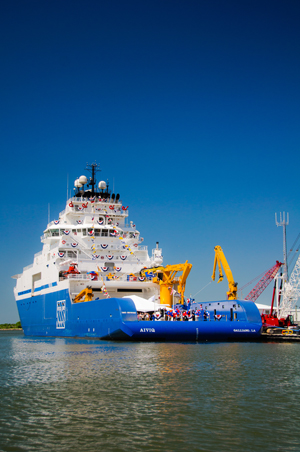In the flotilla of 20 vessels that gathered at Dutch Harbor, Alaska, this summer to spearhead Shell’s six-year, $4.5 billion bid to open the Chukchi and Beaufort seas to drilling, a brand-new ship stood out, gleaming in blue and white.
The vessel was Aiviq, a 360-foot ice-class anchor handler built by Edison Chouest Offshore at a reported cost of $200 million. Two Chouest yards were involved; North American Shipbuilding put together the hull in Larose, La., and LaShip in Houma fabricated the upper house and handled final assembly.
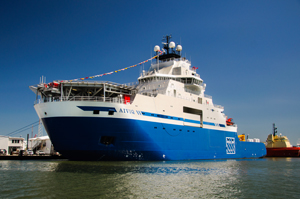 |
|
In its first few weeks at work in Alaska it successfully positioned 16 anchors on the sea floor. |
Aiviq was designed by Chouest’s Gary Rook and was the product of more than 2 million work hours. It’s the largest, most advanced vessel Chouest has ever built and can work equally well in hostile, cold-weather environments and in 10,000 feet of water in the tropics.
“The design question for the vessel was to be able to operate in minus-40 degrees,” Gary Chouest, the company’s CEO, said at the vessel’s christening in Port Fourchon, La. “At the same time, it’s capable of operating in the deepest waters of the world where oil and gas activity exist today.”
Chouest launched its first icebreaker, Nathaniel B. Palmer, for the National Science Foundation 30 years ago. For Aiviq, it tapped Capt. Joe Borkowski, a Palmer veteran with 23 years’ experience in the Antarctic.
 |
Endurance is a key asset of the vessel. Pete Slaiby, vice president of Shell Alaska, says Aiviq can go it alone for about 100 days; it even has its own hospital, with a 22-bed recovery area. And survivability is paramount. Pointing to one of two 64-person fully enclosed, Arctic-class lifeboats, Borkowski said: “It’s a boat in a box. First in the U.S.”
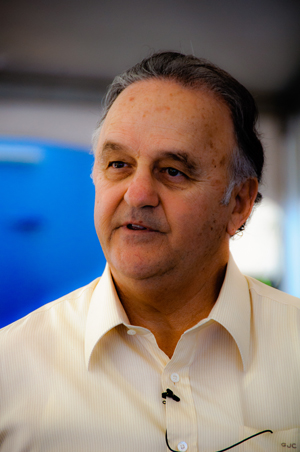 |
|
Gary Chouest at the vessel’s christening. |
On station in support of a rig or drillship, Aiviq’s primary mission is setting and removing anchors. It also offers extensive berthing; the guest space alone, set in a big U in the stern, houses 64 beds, 64 lockers and 64 survival suits. Its secondary task is ice management — gently nudging drifting floes away from the scene of the action. It can also help other purpose-built vessels recover oil in case of an accident.
Aiviq can travel at 5 knots in up to a meter of ice; forward of the engine room there are very strong structural supports, and all exposed piping is protected from stress in ice operations. Two heeling pumps help the ship break ice. “When the vessel runs up on ice, it sloshes water back and forth,” said Chief Engineer Les Amoss.
Aiviq measures 360 feet 8 inches by 80 feet with a depth of 34 feet. The normal draft is 26 feet, slightly less in maximum ice. The main engines are four Caterpillar C280-12 diesels rated at 5,444 bhp each driving two 4,600-mm-diameter controllable-pitch propellers in nozzles via Flender twin-in/single-out gearboxes.
Thruster power is huge. The bow alone has two Brunvoll FU100 2,450-mm thrusters rated at 1,500 kW plus a Rolls-Royce 2,000-kW fold-down. At the stern are two Brunvoll FU80 LTA 2,000-mm thrusters rated at 1,050 kW. There are four Cat 3512C gensets rated at 1,700 kW, two 2,000-kW shaft generators and two Cat C32 910-kW emergency gensets.
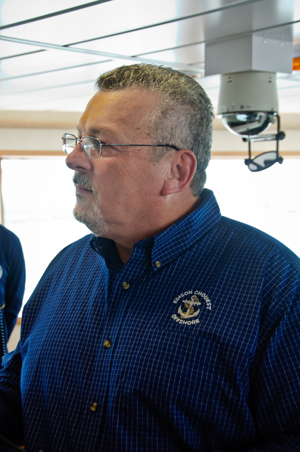 |
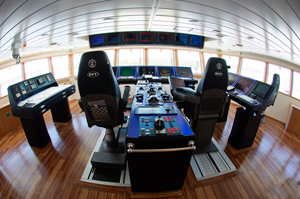 |
|
Capt. Joe Borkowski (above) cut his teeth on Chouest’s Antarctic icebreakers. Aboard Aiviq he will be working with an unusually well-equipped and comfortable bridge. |
Cruising speed is 15 knots in open waters and bollard pull is 200 metric tons. The total clear deck area is 9,150 square feet, more than half of it available to cargo, with a deck strength of 1,024 pounds per square foot. The anchor handling area is 4,270 square feet (for bulk capacities, see specifications, page 19).
The vessel is designed for zero discharge, with water-lubricated stern tubes and dual oily water separators and sewage plants. Ballast water is filtered and organisms trapped. No hydrocarbon fluids sit against the vessel’s hull — the fuel tanks are separated from the sides and bottom by rig water tanks. Aiviq carries a high-volume skimmer for oil recovery and can hold 10,160 barrels of recovered oil.
Aiviq (pronounced EYE-vik) means “walrus” in Inupiaq, and to prepare the way for its Alaska operations, Shell has undertaken a full-scale public relations campaign to reach out to North Slope residents and meet their concerns about environmental sensitivity and the challenge to their way of life. At the vessel’s christening, Shell’s Slaiby noted that the company’s operations will be about 40 miles from Cross Island, where whaling takes place.
“You only have one chance to do it right in Alaska and I feel this is proof positive that everybody takes our commitment to doing things in Alaska in an environmentally sound manner very, very seriously,” he said.
“The people of Nuiqsut are very concerned about our operations. Our operations have the potential to impact them in their garden, and the ocean is their garden.”
Aiviq reflects those concerns in many ways. It’s painted blue and white because whalers believe those colors won’t scare whales away. The diesels meet or exceed Tier-4 emission standards, and Chouest paid a lot of attention to reducing vessel noise. “The engine sits on mounts so it doesn’t transmit noise through the hull,” said Chief Engineer Amoss. When the flotilla left Dutch Harbor for the Chukchi Sea in July and August, an ice management vessel carried equipment to capture an acoustic footprint as Shell sets anchors; Shell plans to share the footprint to help minimize the effect on bowhead and beluga whales.
In the wider world, Shell has also faced criticism from environmental activists. In June, as many of the vessels assembled in Puget Sound (Vigor Marine in Seattle carried out significant prep work and environmental upgrades to the drill rig Kulluk and the drillship Noble Discoverer), the U.S. Coast Guard established a 500-yard safety zone around the flotilla for its passage through the sound, citing the possibility of a protest by Greenpeace.
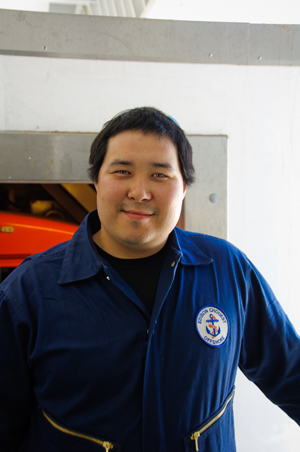 |
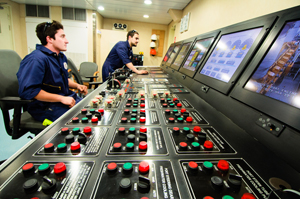 |
|
Bill Soplu (top) is right at home as a crewmember for Aiviq’s Arctic adventure; he hails from a tiny North Slope village. Above, the engine control room. |
At stake, according to Slaiby, are an estimated 25 billion barrels of oil and 120 trillion cubic feet of natural gas if the oilfields live up to expectations. Shell is unusual among major oil companies in having no on-shore drilling or production operations in Alaska, and it has done exploratory drilling in the Chukchi Sea before, in the late 1980s and early ’90s. It has worked hard to satisfy Obama administration safety standards, which became much stricter after the Deepwater Horizon blowout, and it has successfully defended its permits against challenges in court.
As the summer wore on, it became clear that however organized Shell was, there was one thing it couldn’t control: the weather. In August, Curtis Smith, a company spokesman in Alaska, reported that ice in the Chukchi and Beaufort seas was thicker than it had been in more than a decade. Shell had originally hoped to be through the Bering Straits by July 1; instead, it was Aug. 25 before Discoverer left Dutch Harbor for the 800-mile trip to the Chukchi.
And although Interior Secretary Ken Salazar announced the permit to begin preparatory work on Aug. 30, delays with the certification of a spill response barge were preventing deeper drilling. The Interior Department set a Sept. 24 deadline for ending drilling in the Chukchi Sea and Oct. 31 in the Beaufort, and in the end Shell settled for drilling the top 1,400 feet of as many wells as it could this season and drilling them to their full depths in 2013.
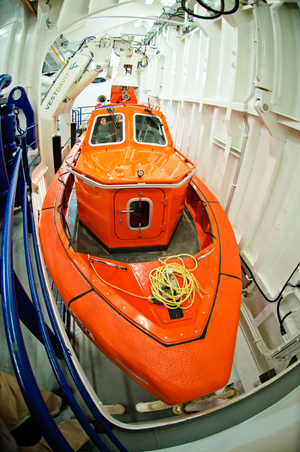 |
|
A 15-person rescue craft on the port side near the cargo deck. |
As Aiviq takes on the job it was designed for, it’s home away from home for its 28 crewmembers. Crew spaces aboard Aiviq are marked by luxurious furniture and cruise ship-like décor, a sign that Chouest thought hard about habitability. Noise and vibrations in the ship’s accommodations are heavily damped, and common spaces abound, with multiple lounge areas, an exercise room, a gleaming galley, and several laundry rooms.
“There’s a lot of space on this boat,” Capt. Borkowski said. “You got a man away from his home six to eight weeks, you need a little space.”
Each stateroom has a private head and there are no stacked bunks. A day mess is accessible from the main deck and available for use without washing up. “A lot of times when you’re pulling anchors you’ve just got a few minutes before you have to get back on deck,” said Borkowski. In the engine room, humidifiers blow a fine mist to keep it workable.
As for safety, the lifeboats are designed for 100 percent capacity on each side of the vessel and there are rescue zones port and starboard. Shell relies heavily on air support for its operations in Alaska and the helideck can handle a Sikorsky S-92. Need hospital treatment? Via Telemed, you’re never far from a specialist at Providence Hospital in Anchorage or Chouest’s company doctor in Louisiana.
Both Chouest and Harvey Gulf have other vessels supporting Shell in Alaska. Harvey Gulf sent Sisuaq, a new PSV from Eastern Shipbuilding, to join Harvey Spirit and Harvey Explorer, two resupply vessels; Chouest’s fleet includes Nanuq, a 301-foot offshore supply vessel with spill response capabilities that Chouest built in 2007.
And like Shell, Chouest has been careful to nurture a relationship with the native peoples of the area (at the christening, Gary Chouest referred to the event as the beginning of a “marriage between South Louisiana and the North Slope of Alaska”).
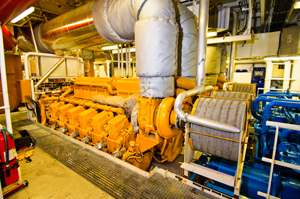 |
|
Scrubbers and cleaners are in place to minimize environmental impact. |
Chouest has held vocational training in Alaska, and at least one young mariner has said he’s grateful for the opportunity and the jobs Chouest has brought to the North Slope. Bill Soplu, from the tiny village of Kaktovik (population: about 300), is working on his third mate’s license and is an Aiviq crewmember.
“I started here as a hawsepiper,” he said, “and I hope to be standing where Captain Joe is standing.”

